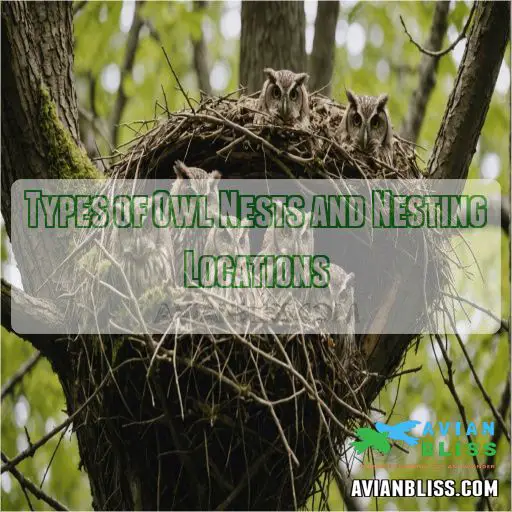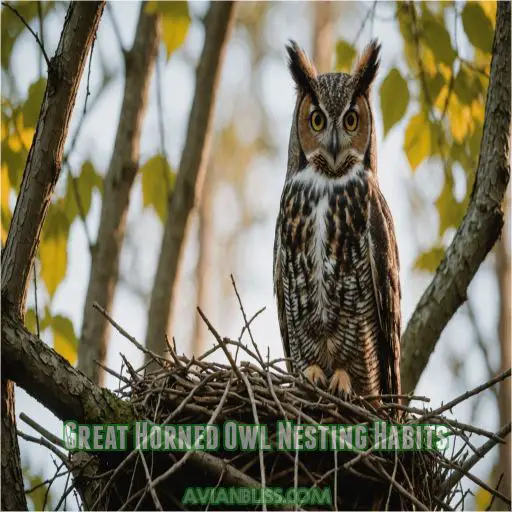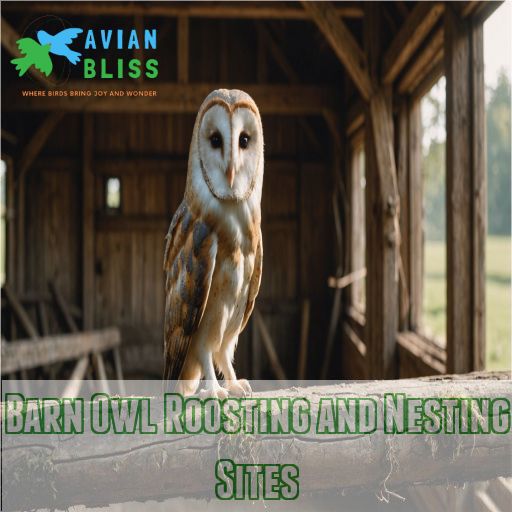This site is supported by our readers. We may earn a commission, at no cost to you, if you purchase through links.

Owl eggs, round like little moonstones, hatch at different times to give older chicks a leg up, literally.
And if you’ve ever wondered about their parenting? It’s quite the hoot! Owls adapt their egg-laying with food supplies, ensuring the kids eat well.
Curious about their housing secrets? Let’s uncover why owls are the ultimate nest connoisseurs.
Table Of Contents
- Key Takeaways
- Types of Owl Nests and Nesting Locations
- Owl Nesting Materials and Construction Techniques
- Owl Egg Laying Patterns and Characteristics
- Owl Nestling Development and Growth Stages
- Great Horned Owl Nesting Habits
- Barn Owl Roosting and Nesting Sites
- Conservation and Support for Owl Nests
- Frequently Asked Questions (FAQs)
- Where do owls make their nests?
- What kind of trees do owls nest in?
- Is it good to have owls around your house?
- How long do owls stay in one place?
- How do weather conditions affect owl nesting success?
- What are common predators of owl nests?
- How do human activities impact owl nesting habits?
- Can owls reuse the same nest for multiple years?
- How do owls select nesting sites based on surrounding habitat?
- Conclusion
Key Takeaways
- You’ll find that owls are the ultimate real estate experts in the bird world, picking everything from tree cavities and abandoned nests to underground burrows and even cactus holes, showing off their adaptability and taste for prime locations.
- When it comes to egg-laying, owls have a staggered approach: older siblings hatch first, gaining a leg up in survival. This "owl relay race" ensures they thrive, especially when synchronized with food availability, like lemming cycles.
- Owls are nature’s recyclers, often using leftovers from past meals as nest materials. Their simple yet effective approach includes lining nests with soft materials like leaves and moss, making their homes comfortable without the need for interior decoration tips from a magazine.
- Those fluffy baby owls grow through distinct stages, starting with a cozy white down, moving to juvenal plumage with unique patterns, and finally achieving their iconic adult look after a complete molt, a true "glow-up" in the avian world.
Types of Owl Nests and Nesting Locations
You won’t believe how eclectic owl nesting habits can be, ranging from high tree cavities to abandoned nests in your own backyard.
Some even nest underground or in buildings, showing that owls have a knack for picking prime real estate, no matter the neighborhood.
Natural Cavities in Trees
Exploring natural cavities in trees? Owls love these special spots!
- Tree cavity size matters
- Cavity competition is fierce
- Prefer specific tree species
- Owls rarely maintain cavities
Abandoned Nests of Other Birds
Rather than building their own nests, many owls simply take over abandoned structures left behind by other birds. This saves time and energy for the owls.
Ground Nests for Grassland and Tundra Species
Grassland and tundra owls cleverly nest right on the ground. Nest site selection and predator avoidance are essential for nesting success amid climate change impacts.
Burrowing Owl Underground Chambers
Shifting from grassland nests, burrowing owls expertly carve underground chambers for predator defense. They:
- Excavate nests
- Interact with rodents
- Create safe shelters
- Store prey.
Building Cavities for Barn and Little Owls
Barn owls and little owls love building cavities.
With a proper nestbox design, cavity size, and location, you’ll create a safe haven for these nocturnal wonders.
| Feature | Barn Owl Preference | Little Owl Preference |
|---|---|---|
| Owl Box Size | Large | Smaller |
| Material Choices | Wood | Mixed Materials |
| Monitoring Nests | Regular checks | Less frequent |
Cactus Holes for Desert Owl Species
Cactus holes provide a cozy home for desert owls, shielding them from harsh conditions.
Competition for these limited spaces can be fierce.
Consider an owl box to lend a helping hand.
Owl Nesting Materials and Construction Techniques
In terms of building nests, owls keep it simple, often using leftovers from past meals—no fancy renovations required!
You might say they’re efficient recyclers, considering prey remains and pellets are their go-to materials, alongside leaves or grass for those open-air style nests.
Use of Prey Remains and Pellets
You’d be surprised: owls double as nature’s recyclers!
Through owl pellet analysis, scientists gain insights into nesting hygiene and food source indicators.
Pellet composition often reveals prey size estimation and populations, showcasing the intricacy of owl hunting habits.
Lining of Open Nests With Soft Materials
Owls often use soft materials to line their open nests, cushioning their eggs like a cozy blanket.
It’s akin to filling your favorite chair with pillows.
Some common choices include:
- Leaves
- Grass
- Soft moss
- Feathers
Great Gray Owl’s Platform Nest Building
The Great Gray Owl, a true architectural marvel, constructs its own platform nest high in the trees.
It carefully weaves sticks and twigs to create a cozy, secure home for its young.
Lack of Added Materials in Most Owl Nests
Most owls skip the luxury of a furnished nest, instead relying on pellet composition, like bones and feathers, for nest sanitation.
When considering an owl box, think about natural lining for hygiene and potential disadvantages.
Owl Egg Laying Patterns and Characteristics
You’ve probably never wondered why owl eggs are as round as they are, but these spherical wonders are perfectly timed with nature to guarantee owlets are born when dinner’s most abundant.
Owl eggs hatch in a staggered manner, giving older siblings a hasty start in life’s survival marathon.
As if playing a game of egg roulette, owls stagger hatching, giving older siblings a hasty start in life’s survival marathon.
Timing of Egg Laying With Prey Populations
Timing is key for egg laying. By linking egg laying with prey populations, like lemming cycles, owls make sure their young have enough to eat, boosting nesting success rates.
Spherical Shape of Owl Eggs
Owls’ spherical eggs offer an evolutionary advantage – their unique shape provides extra strength and stability in their nesting cavities.
- Spherical shape distributes weight evenly
- Prevents cracking and breakage
- Allows for efficient heat transfer
- Facilitates smooth rolling to reposition eggs
Asynchronous Hatching and Age Differences
You know, owl eggs hatch like they’re in a relay race—first out gets the best worms!
This staggered arrival helps older siblings thrive, creating a pecking order in the nest.
Egg Count Variations Among Owl Species
Having explored size differences, let’s see why owls lay a range of eggs:
- Snowy owls: up to 12 eggs.
- Barn owls: 6-8 eggs.
- Evolutionary pressures.
- Clutch size varies.
Impact of Food Availability on Clutch Size
Various owl species lay more eggs when food is plentiful.
Like a buffet, more prey abundance leads to larger clutch sizes, boosting nestling survival.
Consider the "owl box reviews" for insights.
Owl Nestling Development and Growth Stages
As young owls grow, they develop a remarkable set of adaptations.
From their fluffy white natal down to their striking juvenal plumage, these feathered wonders undergo an incredible transformation before molting into their iconic adult look.
Two Coats of White Natal Down
Like a cozy sweater, the first coat of white natal down keeps Downy Owls snug and safe. As they grow, their second coat provides extra warmth, showing rapid nestling development.
Juvenal Plumage Characteristics
As young owls grow two coats of white natal down, they begin developing juvenal plumage.
Juvenal plumage is characterized by:
- Color variations
- Unique feather patterns
- Identification markers
- Early molting signs
A real hoot!
First Flight Feather Appearance
Juvenile plumage adorns nestlings as their wing development peaks with the appearance of first flight feathers.
Imagine short-eared and barred eagle owls, their wing area expanding—soon they’ll soar with newfound freedom.
| Owl Species | Initial Flight Feather Age | Wing Area (cm²) | Flight Learning Phase |
|---|---|---|---|
| Short-Eared Owl | 3 weeks | 650 | Curiosity |
| Barred Eagle Owl | 4 weeks | 720 | Exploration |
| Spot-Bellied Owl |
3.5 weeks
Complete Molt to Adult Plumage
After fledging, young owls undergo a complete molt, shedding their juvenile plumage and donning their distinctive adult feathers – a transformation that marks their maturity.
Size Differences and Survival Rates
Among owl nests, sibling rivalry can be a hoot! Size differences impact survival odds; older nestlings outmuscle younger ones for food, impacting nestling health and survival rates.
Great Horned Owl Nesting Habits
You might be surprised to find great horned owls nesting right in your own neighborhood, as they’re not picky about living near high-rise buildings or busy streets.
These adaptable birds take over nests abandoned by others, cleverly reusing hawk or squirrel homes—like renting a cozy winter cabin, minus the repairs like renting a cozy winter cabin!
Urban and Suburban Nesting Locations
Great horned owls embrace suburban life, showcasing urban adaptation.
They favor surprising places, such as:
- Residential areas buzzing with activity
- Skyscrapers echoing their hoots
- Sometimes, busy streets for prime owl nest density.
Nest Selection and Takeover Strategies
Owls often commandeer existing nests built by other birds, with red-tailed hawk nests being a favorite. They fiercely defend their nesting territory against competitors.
Nest Takeover Tactics
| Nest Takeover Tactics | Preferred Nest Types |
|---|---|
| Occupy old hawk/crow nests | Tree cavities, cliff ledges |
| Displace other owls, raptors | Abandoned woodpecker holes |
| Evict squirrels, bald eagles | Cactus cavities (desert owls) |
| Aggressively defend territory | Ground nests (grassland owls) |
Preferred Nest Types
Winter Nesting and Cold Adaptations
As you consider nest selection and takeovers, think about owl insulation during winter.
Risking frostbite, they brave northern latitudes’ snow cover.
Cold tolerance keeps them active every month, regardless.
Stay cozy, owls!
Parental Care and Feeding Behaviors
While keeping their fluffy owlets warm, parents play active roles, ensuring abundant food.
Feedings, however, aren’t a silver bullet—survival hinges on prey preferences and sibling rivalry, like a real-life drama.
Nesting Territory Size and Defense
You’re doing great watching over your owl family! The thing about nesting territory is it’s prime real estate. Boundaries overlap, leading to disputes and showcasing owl aggression.
- Territory overlap
- Nest site disputes
- Owl aggression
Barn Owl Roosting and Nesting Sites
Barn owls have a long history of nesting in human structures, from church towers to old barns, often in old buildings or trees.
These versatile birds often take up residence in modern agricultural buildings, as long as the right cozy nooks and crannies are available.
Historical Nesting in Human Structures
great horned owls adapt to diverse habitats, but barn owls have nested in human structures for centuries. Imagine searching ancient church towers for owls and discovering barn owl history within.
Modern Nestbox Usage in Agricultural Buildings
Modern farming has evolved, leading to barn owls embracing nestboxes.
Craft thoughtful designs, and strategically place them for the owl’s benefit.
Careful monitoring enhances conservation impacts and helps create thriving owl populations.
Roosting Preferences and Energy Conservation
When winter whispers through the trees, Barn Owls cleverly conserve energy by choosing roosts with:
- Nestbox design using insulating straw,
- Preferred roosting materials like wood,
- Elevated roosting height.
Loss of Traditional Nest Sites
The majority of traditional Barn Owl roosts and nests have vanished due to changes in farming practices, leaving them without suitable places to call home like barns and sheds.
Minimum Requirements for Nest Site Selection
Looking to host barn owls? Make sure their nestboxes feature precise measurements: cavity size of 70 x 70mm, ledge width of 250mm, and floor area of 300 x 300mm. Isolation helps too!
Conservation and Support for Owl Nests
You’ve got a great opportunity to help owls by supporting their unique nesting needs with artificial nest boxes and preserving natural habitats.
Reducing competition from non-native species and keeping domestic cats indoors can work wonders for these amazing creatures.
Providing Artificial Nest Boxes
Consider nest boxes as real estate for owls, a key element for attracting owls
Make sure the design is sturdy, select safe materials, and prioritize strategic placement.
Monitor their success, and don’t forget to engage your community in this feathered endeavor!
Preserving Natural Nesting Habitats
Safeguarding owl havens is really important – protect old-growth forests, limit development, and restore natural landscapes.
Your backyard can be an oasis for these remarkable raptors.
- Preserve mature woodlands and meadows
- Avoid using pesticides and rodenticides
- Install owl-friendly nestboxes in your yard
Reducing Competition From Non-Native Species
Don’t let non-native species crash your local owls’ party! Their presence can lead to native owl decline.
Innovative conservation strategies, like clever nestbox design, can help reduce competition and safeguard these majestic birds.
Limiting Use of Pesticides and Poisons
Examining owl pesticide impact reveals threats to these raptors. Switch to organic farming with these steps:
- Use natural pest deterrents.
- Implement crop rotation.
- Encourage beneficial insects.
- Avoid chemical treatments.
Keeping Domestic Cats Indoors
Cats, while adorable, are stealthy hunters.
Keeping them indoors boosts owl safety.
Table: benefits, cat behavior, wildlife impact.
| Benefit | Cat Behavior |
|---|---|
| Owl Safety | Less predation |
| Wildlife Impact | Reduced stress |
Engage cats indoors with fun enrichment!
Frequently Asked Questions (FAQs)
Where do owls make their nests?
You’d be surprised where owls make their nests!
Owls find the perfect spot to raise their young, no matter the terrain.
From cozy tree cavities to perching atop towering cliffs, these clever birds find the perfect spot to raise their young, no matter the terrain.
Their adaptability is truly a hoot!
What kind of trees do owls nest in?
Owls often choose trees like oaks, pines, and cedars for nesting.
These provide cozy hollow spaces, offering a snug fortress against dangers.
Think of them as the owl’s luxury condos, perched high for peace and privacy.
Is it good to have owls around your house?
Having owls around your house is like having nature’s pest control on call.
These nocturnal birds keep rodents in check, offering a hoot-worthy benefit while adding a touch of mystery and magic to your nights.
How long do owls stay in one place?
Owls can stay in one location for a period ranging from a few months to several years.
The length of their stay depends on factors such as the availability of their favorite café and secure nesting sites.
Cozy homes provide owls with a sense of freedom.
How do weather conditions affect owl nesting success?
Weather conditions can greatly impact owl nesting success.
Rainy, cold, or drought-like weather may reduce food availability and make it harder for owls to keep their eggs and young warm, leading to lower reproductive rates.
What are common predators of owl nests?
Just like a thief in the night, predators often target owl nests.
Common nest threats include raccoons, crows, snakes, and even larger raptors.
Protecting their young, parent owls fiercely defend against these cunning invaders.
How do human activities impact owl nesting habits?
You’ll find that human activity, like urban development or agriculture, often turns owl neighborhoods topsy-turvy.
These changes can clip their housing options, disrupting their cozy tree hideouts or ground nests, making survival a taller order (Source).
Can owls reuse the same nest for multiple years?
Owls can be picky nesters, reusing the same site for years if it suits them.
But, just like house-hunting humans, they can face "location, location, location" issues with nests deteriorated or occupied by others (Source).
How do owls select nesting sites based on surrounding habitat?
Ah, the art of nesting – where owls showcase their uncanny ability to sniff out the perfect pad.
You’d be surprised how these feathered architects size up their surroundings, seeking out cozy cavities that scream "home sweet home.
Conclusion
When it comes to **owl nests**, these incredible birds might as well be the real estate moguls of the animal kingdom, choosing their homes based on the best **time to look for owls**!
You’ve discovered how they adapt to diverse environments, whether huddled in a tree cavity or nestled in an underground burrow.
Equipped with ingenious nesting habits, they make sure their young thrive.
By understanding and supporting their habitats, you can help preserve these masterful architects, making sure owls continue to soar as mysterious neighbors in our ecosystems.










